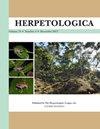人工位移改变陆生两栖动物的运动行为
IF 1.1
3区 生物学
Q2 ZOOLOGY
引用次数: 1
摘要
摘要:两栖动物的归巢能力已被广泛记录,但尚不清楚在缺乏与繁殖和地点保真度相关的动机线索的情况下,个体是否有归巢倾向。我们测试了人工移位是否会影响非hilopatic陆地两栖动物Fowler's Toad(Anaxyrus fowleri)在其栖息地范围内以及繁殖季节结束后的运动行为。我们在三个不同的距离(100米、250米和500米)中的一个距离内,从捕获的初始点对65只雄性和雌性福勒蟾蜍进行了总共104次的转移,并将这些蟾蜍随后24小时的移动与43只未翻译蟾蜍的对照组的移动进行了比较。为了保护迁移的蟾蜍在途中免受听觉、视觉和嗅觉线索的影响,我们将它们转移到不透明的封闭盒子中,并在加拿大安大略省朗角伊利湖海岸线均匀无阻碍的景观中进行了实验。我们主要研究了方向性偏差作为对照组和易位组之间的定向,归巢倾向作为易位后运动与易位距离之间的相关性,归巢准确性作为最终捕获点和初始捕获点之间距离的变化。我们的研究结果提供了明确的证据,证明迁移改变了这些蟾蜍的运动行为,并且它们在繁殖季节之外具有归巢的倾向。蟾蜍有很强的方向偏移,可以向与它们被人为移位的方向相反的方向移动,而对照组在记录的61次24小时移动中没有显示方向偏移。两栖动物在人工迁移后回家的趋势可能是任何涉及其迁移的程序中的一个重要混杂因素。本文章由计算机程序翻译,如有差异,请以英文原文为准。
Artificial Displacement Alters Movement Behavior of a Terrestrial Amphibian
Abstract: Homing abilities have been widely documented in amphibians, but it remains unclear whether individuals have homing tendencies in the absence of motivational cues related to breeding and site fidelity. We tested whether artificial displacement would affect the movement behavior of a nonphilopatric terrestrial amphibian, the Fowler's Toad (Anaxyrus fowleri), within its home range and after its breeding season had ended. We translocated 65 male and female Fowler's Toads from their initial points of capture a total of 104 times over one of three different distances (100 m, 250 m, and 500 m) and compared these toads' subsequent 24-h movements with those of a control group of 43 untranslocated toads. To shield the translocated toads from auditory, visual, and olfactory cues en route, we translocated them in opaque enclosed boxes and performed the experiment in the uniformly unobstructed landscape of the Lake Erie shoreline of Long Point, ON, Canada. We mainly investigated directionality bias as the orientation between control and translocated groups, homing tendency as the correlation between movements after translocation and translocation distance, and homing accuracy as the variation in distance between final and initial capture points. Our results provide clear evidence that translocation changes the movement behavior of these toads and that they possess homing tendencies outside of their breeding season. Toads had a strong directional bias to move in the opposite direction to the one in which they were artificially displaced, in contrast with the control group, which showed no directional bias among 61 recorded 24-h movements. This tendency for amphibians to home after artificial displacement might be a significant confounding factor in any procedure involving their relocation.
求助全文
通过发布文献求助,成功后即可免费获取论文全文。
去求助
来源期刊

Herpetologica
生物-动物学
CiteScore
4.60
自引率
0.00%
发文量
27
审稿时长
>12 weeks
期刊介绍:
Established in 1936, Herpetologica is a quarterly peer-reviewed journal serving herpetologists, biologists, ecologists, conservationists, researchers and the scientific community. The journal contains original research papers and essays about the biology of reptiles and amphibians, and covers many relevant topics including: behavior, conservation, ecology, genetics, morphology, physiology and taxonomy.
 求助内容:
求助内容: 应助结果提醒方式:
应助结果提醒方式:


